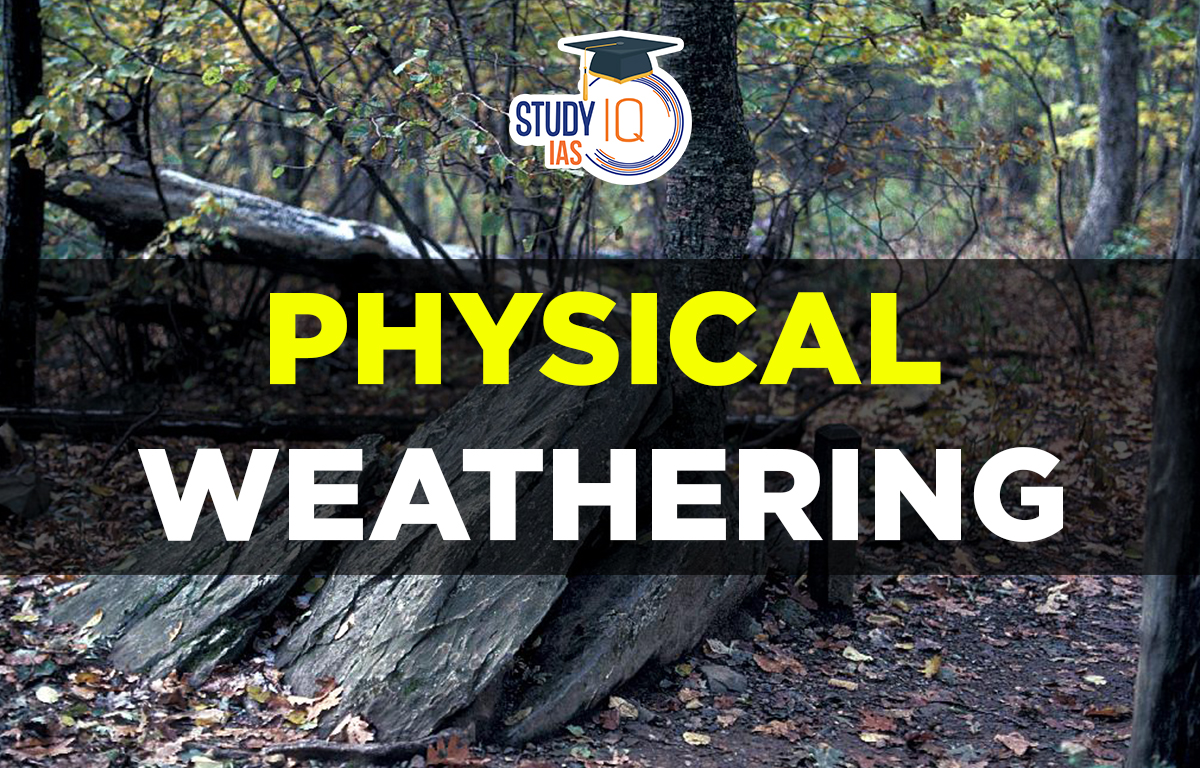Table of Contents
Physical Weathering
Physical or mechanical weathering is when rocks break into smaller pieces without changing their chemical makeup. This happens through processes like freezing and thawing, salt buildup, and heat causing cracks. The forces that break the rocks can come from inside the rock or from the environment around it. This Weathering activity is more dominant and prominent in deserts, high mountains, and arctic regions.
Physical Weathering Types
Physical Weathering processes can be of many types. For example,
- Water enters cracks in rocks, freezes, and breaks the rock apart (frost wedging).
- Big temperature changes in hot deserts can cause rocks to crack.
- Tree roots grow into cracks, making them bigger and breaking the rock.
- Salt buildup in dry areas can cause rocks to split.
Physical Weathering Freezing, Thawing & Frost Shattering
While most substances expand when heated and contract when cooled, water behaves differently. Water expands when it freezes. This expansion results in generating cryostatic pressure. In cold areas, small cracks in rocks can fill with water during the day. When the water freezes, it expands and can break the rock. This happens when the pressure from the ice is stronger than the rock itself. This process is called frost shattering.
Read More: Chemical Weathering
Physical Weathering Expansion Resulting from Unloading
The release of pressure in the rock also causes physical weathering. The pressure is released due to the removal of overlying material by erosion. This process is known as unloading. It is a typical phenomenon resembling the elastic property of rubber. As the pressure is released above the rock, the underlying rock elastically compensates for the erosional loss by expanding perpendicular to the direction of pressure release. This unloading of pressure by the rock results in a horizontal fracture. These fractures are arranged horizontally and are called sheet fractures or exfoliation sheets.
Read More: Biological Weathering
Physical Weathering Thermal Expansion & Contraction or Insolation
Minerals can only expand and contract so much. When temperatures rise, minerals expand and push against nearby rocks. When temperatures drop, they contract. This cycle of expanding and contracting happens regularly with daily temperature changes. It is especially effective in dry areas and high altitudes. This process makes surfaces rounder because of the different heating (which causes expansion) and cooling (which causes contraction). An example of this is granite.
Read More: Types of Rocks
Physical Weathering Salt
The saline water present in the pore spaces evaporates with the rise in temperature in the daytime and leaves behind salt crystals. The expanding salt crystals exert pressure on the walls of rock pores, thus, causing disintegration or foliation of rock. Such types of weathering are mostly found in areas where a high range of temperatures are found.
Physical Weathering Processes
Rocks experience physical weathering when changes in temperature disrupt their structure. Water can help with this process. When water gets into cracks, freezes, and expands, it goes through freeze-thaw cycles, which can eventually break the rock apart.
Physical Weathering Significance
- It reduces the original rock to tiny bits, preparing the rock for the development of soil. As a result, the rock’s weathering determines how deep the soil is.
- Forests rely on weathered rock thickness for different ecosystems and biodiversity.
- Without weathering, erosion is less impactful, creating smoother landscapes with less debris.
- Weathering concentrates valuable minerals (iron, manganese, aluminum, copper) important for the economy.
- It breaks down rock into sediments, aiding soil formation.
- Sediments can become sedimentary rocks (sandstone, limestone) under pressure, often from rivers.
- Weathering makes rocks easier to mine.
- Some weathered rocks, like granite tors, are popular tourist attractions.
Read More: Mass Movement
Physical Weathering UPSC
Materials on hillslopes deteriorate and fall apart as a result of physical deterioration. The effects of physical weathering processes can be seen in many landforms. Rocks are eroded by weathering, resulting in the formation of soil. Additionally, it aids in mass transfer and erosion. The result is that the plant prospers. Terrain changes are a result of weathering, which encourages erosion and mass depletion. The national economy benefits from the enrichment and enrichment of ores such as iron, copper, and others.
The topic “Physical Weathering”, which is an important element of the UPSC Exam’s Geography Syllabus, should be thoroughly studied by candidates.


 Role of Teachers in Educations, Student ...
Role of Teachers in Educations, Student ...
 India's achievements after 75 years of I...
India's achievements after 75 years of I...
 Bal Gangadhar Tilak Biography, Achieveme...
Bal Gangadhar Tilak Biography, Achieveme...

























